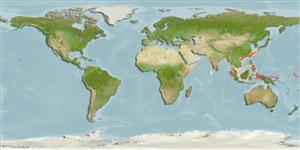Common names from other countries
分類 / Names
俗名 | 同種異名 | Catalog of Fishes(屬, 種) | ITIS | CoL | WoRMS | Cloffa
Teleostei >
Siluriformes (Catfishes)
鯰形目 (Catfishes) >
Ariidae (Sea catfishes)
海鯰科 (Sea catfishes) > Ariinae
Etymology: Arius: Greek, arios, areios = dealing with Mars, warlike, bellicose (Ref. 45335).
Environment: milieu / climate zone / depth range / distribution range
生態學
海洋; 淡水; 半鹹淡水 居於水底的; 河川洄游 (Ref. 51243); 深度上下限 50 - 100 m (Ref. 28016). 熱帶; 33°N - 4°S
Indo-West Pacific: off the west and east coast of India, Sri Lanka, Pakistan, Bangladesh, Myanmar to the Arafura Sea (Ref. 9819) and the Indo-Australian Archipelago (excluding Australia). Known from the Mekong Delta (Ref. 12693).
印度-西太平洋: 外海的印度西部與東部海岸,斯里蘭卡,巴基斯坦,孟加拉, 緬甸到阿拉弗拉海 (參考文獻 9819) 與印澳群島.(排除澳洲) 已知來自湄公河三角州了。 (參考文獻 12693)
Length at first maturity / 大小 / 重量 / 年齡
Maturity: Lm ?, range 38 - ? cm
Max length : 80.0 cm TL 雄魚/尚未辨別雌雄; (Ref. 11441); common length : 30.0 cm TL 雄魚/尚未辨別雌雄; (Ref. 3290)
背棘 (總數) : 1; 背的軟條 (總數) : 7; 臀鰭軟條: 16 - 30. Head shield somewhat rugose; deep and long median fontanelle groove.
頭盾略微多皺紋的; 深的而且長的中央囪門凹槽。
Adults occurs in inshore waters and estuaries. Occasionally form schools. Feed on invertebrates and small fishes. Males incubate eggs in the mouth (Ref. 205). Caught mainly with set bag nets and bamboo stake traps. Marketed fresh (Ref. 3290). Air bladders are exported as isinglass used by the wine industry (Ref. 43081). Strong venomous dorsal and pectoral spines provide protection for the fish (Ref. 43081).
出現於近岸水域與河口。 捕食無脊椎動物與小魚。 偶然地形成魚群。 主要地以定置袋網與竹製魚籠捕捉。 在市場上銷售生鮮地了。 (參考文獻 3290) 氣鰾輸出作為被製酒業使用的魚膠。 (參考文獻 43081) 強的有毒背部的與胸棘給魚提供保護.(參考文獻 43081)
Males incubate eggs in buccal cavity. During incubation, males starve which sometimes make them resort to swallowing one or two eggs probably to maintain basal metabolism (Ref. 43081). Early hatching embryos commence feeding on inhaled particles by the female when still in possession of large yolk.印度-西太平洋: 外海的印度西部與東部海岸,斯里蘭卡,巴基斯坦,孟加拉, 緬甸到阿拉弗拉海 (參考文獻 9819) 與印澳群島.(排除澳洲) 已知來自湄公河三角州了。 (參考文獻 12693)
Kailola, P.J., 1999. Ariidae (=Tachysuridae): sea catfishes (fork-tailed catfishes). p. 1827-1879. In K.E. Carpenter and V.H. Niem (eds.) FAO species identification guide for fishery purposes. The living marine resources of the Western Central Pacific. Vol. 3. Batoid fishes, chimaeras and bony fishes part 1 (Elopidae to Linophrynidae). FAO, Rome. (Ref. 38478)
CITES (Ref. 128078)
Not Evaluated
人類使用
漁業: 商業性
工具
特別的報告
下載 XML
網路資源
Estimates based on models
Preferred temperature (Ref.
115969): 22.5 - 28.2, mean 26.4 (based on 130 cells).
Phylogenetic diversity index (Ref.
82804): PD
50 = 0.5000 [Uniqueness, from 0.5 = low to 2.0 = high].
Bayesian length-weight: a=0.00933 (0.00589 - 0.01479), b=3.05 (2.92 - 3.18), in cm Total Length, based on LWR estimates for this species & (Sub)family-body (Ref.
93245).
營養階層 (Ref.
69278): 3.4 ±0.46 se; based on food items.
回復力 (Ref.
120179): 中等的, 族群倍增時間最少 1.4 - 4.4年 (tmax=7).
Fishing Vulnerability (Ref.
59153): Moderate vulnerability (36 of 100).
